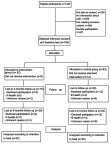Effects of a behavioral medicine intervention on pain, health, and behavior among community-dwelling older adults: a randomized controlled trial
- PMID: 31308644
- PMCID: PMC6615714
- DOI: 10.2147/CIA.S208102
Effects of a behavioral medicine intervention on pain, health, and behavior among community-dwelling older adults: a randomized controlled trial
Abstract
Purpose: The aim of the study was to evaluate the effects of an intervention, based on a behavioral medicine approach in physical therapy (BMPI), on pain-related disability and physical performance as well as on pain severity, pain catastrophizing, physical activity levels, falls efficacy, and health-related quality of life (HRQL) by comparing the effects to standard care.
Patients and methods: The study was a pragmatic randomized controlled trial with a two-group design and included measurements preintervention and postintervention and a 12-week follow-up. In total, 105 older adults, aged >75 years with chronic musculoskeletal pain living alone at home and dependent on formal care to manage their everyday lives, were included in the study. All statistical analyses were performed using an intention to treat approach.
Results: The intervention, based on a behavioral medicine approach, compared to usual care, had a positive effect on pain-related disability, pain severity, level of physical activity, HRQL, management of everyday life, and self-efficacy.
Conclusion: BMPI can be a suitable evidence-based intervention for community-dwelling older adults, even for those who are very old and frail. BMPI can support and promote an active aging and "age in place" for the target population, which is currently the main goal of all interventions in this field.
Keywords: active aging; behavior change; exercise; pain management; physical therapy; self-efficacy.
Conflict of interest statement
The authors report no conflicts of interest in regard to this work.
Figures
Similar articles
-
A behavioral medicine intervention for older women living alone with chronic pain - a feasibility study.Clin Interv Aging. 2014 Aug 18;9:1383-97. doi: 10.2147/CIA.S66943. eCollection 2014. Clin Interv Aging. 2014. PMID: 25170262 Free PMC article. Clinical Trial.
-
A multicomponent intervention for the management of chronic pain in older adults: study protocol for a randomized controlled trial.Trials. 2017 Nov 9;18(1):528. doi: 10.1186/s13063-017-2270-3. Trials. 2017. PMID: 29121961 Free PMC article. Clinical Trial.
-
A physical activity program versus usual care in the management of quality of life for pre-frail older adults with chronic pain: randomized controlled trial.BMC Geriatr. 2020 Oct 8;20(1):396. doi: 10.1186/s12877-020-01805-3. BMC Geriatr. 2020. PMID: 33032532 Free PMC article. Clinical Trial.
-
The effectiveness, suitability, and sustainability of non-pharmacological methods of managing pain in community-dwelling older adults: a systematic review.BMC Public Health. 2019 Nov 8;19(1):1488. doi: 10.1186/s12889-019-7831-9. BMC Public Health. 2019. PMID: 31703654 Free PMC article.
-
A Scoping Review of Nonpharmacological Interventions to Reduce Disability in Older Adults.Gerontologist. 2020 Jan 24;60(1):e52-e65. doi: 10.1093/geront/gnz026. Gerontologist. 2020. PMID: 31002312 Free PMC article.
Cited by
-
Effectiveness of community-based interventions for older adults living alone: a systematic review and meta-analysis.Epidemiol Health. 2024;46:e2024013. doi: 10.4178/epih.e2024013. Epub 2024 Jan 3. Epidemiol Health. 2024. PMID: 38228090 Free PMC article.
-
Therapeutic Recommendations for the Management of Older Adult Patients with Sjögren's Syndrome.Drugs Aging. 2021 Apr;38(4):265-284. doi: 10.1007/s40266-021-00838-6. Epub 2021 Feb 23. Drugs Aging. 2021. PMID: 33619703 Review.
-
Physical activity and sedentary behaviour interventions for people living with both frailty and multiple long-term conditions and their informal carers: a scoping review and stakeholder consultation.Age Ageing. 2024 Nov 4;53(11):afae255. doi: 10.1093/ageing/afae255. Age Ageing. 2024. PMID: 39558868 Free PMC article.
-
The Effect of Occupational Engagement on Lifestyle in Adults Living with Chronic Pain: A Systematic Review and Meta-analysis.Occup Ther Int. 2022 Jun 13;2022:7082159. doi: 10.1155/2022/7082159. eCollection 2022. Occup Ther Int. 2022. PMID: 35814357 Free PMC article.
-
Acceptability and Feasibility of a Pain and Depressive Symptoms Management Intervention in Middle-Aged and Older African American Women.Innov Aging. 2023 Sep 8;7(10):igad096. doi: 10.1093/geroni/igad096. eCollection 2023. Innov Aging. 2023. PMID: 38094930 Free PMC article.
References
Publication types
MeSH terms
LinkOut - more resources
Full Text Sources
Medical


